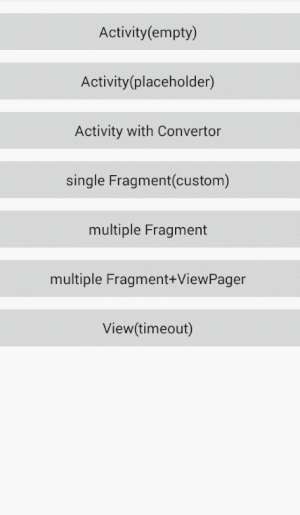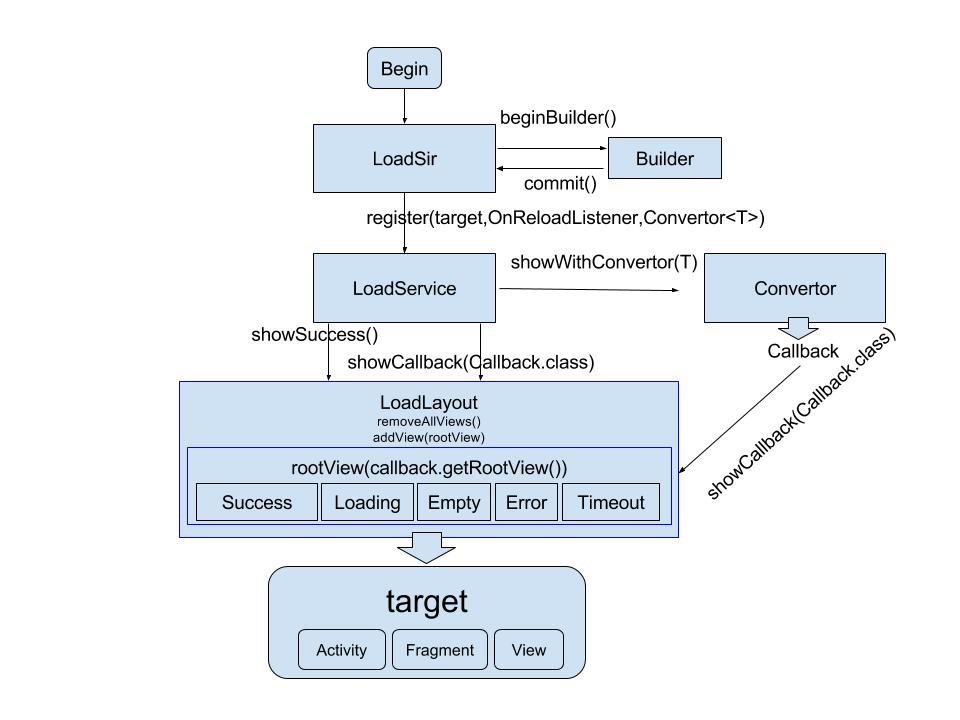English | 中文
LoadSir is a lightweight, good expandable Android library used for displaying different pages like loading, error, empty, timeout or even your custom page when you load data from database or a REST service. LoadSir is very different from other similar libraries. I mean... better.
| in Activity | in View | in Fragment |
|---|---|---|
 |
 |
 |
| Placeholder | Multi-Fragment | ViewPager+Fragment |
|---|---|---|
 |
 |
 |
- ⭐ support for Activity, Fragment, Fragment(v4), View
- ⭐ support for Multi-Fragment, Fragment+ViewPager
- ⭐ convert http result structure into a Callback
- ⭐ no need to modify the layout
- ⭐ only load one layout once
- ⭐ no need to set enum or constant for status code
- ⭐ set your own onClick logic in custom Callback
- ⭐ no preloaded load page
- ⭐ support for keeping the toolbar, titleview
- allow to customize your own load page
- set the retry onClick listener
OnReloadListener - set the default load page
- add multi load pages
- thread-safety
LoadSir only needs 3 steps: 1. Config -> 2. Register -> 3. Display
compile 'com.kingja.loadsir:loadsir:1.3.6'There are two ways to set the config. Add your custom pages and set the default page.
Set config with singleton pattern, you can do it in your Application. No matter where you do this job, you could get the unique LoadSir everywhere.
public class App extends Application {
@Override
public void onCreate() {
super.onCreate();
LoadSir.beginBuilder()
.addCallback(new ErrorCallback())
.addCallback(new EmptyCallback())
.addCallback(new LoadingCallback())
.addCallback(new TimeoutCallback())
.addCallback(new CustomCallback())
.setDefaultCallback(LoadingCallback.class)
.commit();
}
}If you want to create another specific LoadSir, you can set config like this.
LoadSir loadSir = new LoadSir.Builder()
.addCallback(new LoadingCallback())
.addCallback(new EmptyCallback())
.addCallback(new ErrorCallback())
.build();
loadService = loadSir.register(this, new Callback.OnReloadListener() {
@Override
public void onReload(View v) {
// retry logic
}
});Tell LoadSir which "layout" you want to be replaced with LoadLayout.
The registered Activity will be handled by LoadSir.
@Override
protected void onCreate(@Nullable Bundle savedInstanceState) {
super.onCreate(savedInstanceState);
setContentView(R.layout.activity_content);
// You can change the callback on sub thread directly.
LoadService loadService = LoadSir.getDefault().register(this, new Callback.OnReloadListener() {
@Override
public void onReload(View v) {
// your retry logic
}
});
}The registered ImageView will be handled by LoadSir.
ImageView imageView = (ImageView) findViewById(R.id.iv_img);
LoadSir loadSir = new LoadSir.Builder()
.addCallback(new TimeoutCallback())
.setDefaultCallback(LoadingCallback.class)
.build();
loadService = loadSir.register(imageView, new Callback.OnReloadListener() {
@Override
public void onReload(View v) {
loadService.showCallback(LoadingCallback.class);
// your retry logic
}
});The registered Fragment will be handled by LoadSir.
Use it in Fragment is a bit different from the other two, follow the template code.
@Nullable
@Override
public View onCreateView(LayoutInflater inflater, @Nullable ViewGroup container, @Nullable Bundle savedInstanceState) {
//step 1:obtain root view
rootView = View.inflate(getActivity(), R.layout.fragment_a_content, null);
//step 2:obtain the LoadService
LoadService loadService = LoadSir.getDefault().register(rootView, new Callback.OnReloadListener() {
@Override
public void onReload(View v) {
// your retry logic
}
});
//step 3:return the LoadLayout from LoadService
return loadService.getLoadLayout();
}What to show after fetching data (from REST service or database...)?
protected void loadFromNet() {
// do net job/load data...
// callback after finish
loadService.showSuccess(); // successful case -> show the data, eg RecyclerView,...
--- OR ---
loadService.showCallback(EmptyCallback.class); // do/show something else
}Info: showSuccess() calls the SuccessCallback to "hide" LoadSir and show the content.
If you want LoadSir to do callback automatically, you can pass a Convertor when you register.
LoadService loadService = LoadSir.getDefault().register(this, new Callback.OnReloadListener() {
@Override
public void onReload(View v) {
// retry logic
}}, new Convertor<HttpResult>() {
@Override
public Class<? extends Callback> map(HttpResult httpResult) {
Class<? extends Callback> resultCode = SuccessCallback.class;
switch (httpResult.getResultCode()) {
case SUCCESS_CODE:
if (httpResult.getData().size() == 0) {
resultCode = EmptyCallback.class;
}else{
resultCode = SuccessCallback.class;
}
break;
case ERROR_CODE:
resultCode = ErrorCallback.class;
break;
}
return resultCode;
}
});Pass a HttpResult, now you start up a robot LoadSir.
loadService.showWithConvertor(httpResult);You can customize your own load page like loading, empty, error, timeout, etc. Provide the layout and fill the retry logic (if necessarily).
public class CustomCallback extends Callback {
@Override
protected int onCreateView() {
return R.layout.layout_custom;
}
@Override
protected boolean onReloadEvent(final Context context, View view) {
Toast.makeText(context.getApplicationContext(), "Hello buddy! :p", Toast.LENGTH_SHORT).show();
(view.findViewById(R.id.iv_gift)).setOnClickListener(new View.OnClickListener() {
@Override
public void onClick(View v) {
Toast.makeText(context.getApplicationContext(), "It's your gift! :p", Toast.LENGTH_SHORT).show();
}
});
return true;
}
//set visibility of SuccessView when callback is attach to Layout,true:visible, false: invisible
@Override
public boolean getSuccessVisible() {
return super.getSuccessVisible();
}
//Called when the view of Callback is attached to LoadLayout.
@Override
public void onAttach(Context context, View view) {
super.onAttach(context, view);
}
//Called when the view of Callback was detached from LoadLayout.
@Override
public void onDetach() {
super.onDetach(context, view);
}
}Access the view of a Callback.
loadService = LoadSir.getDefault().register(...);
loadService.setCallBack(EmptyCallback.class, new Transport() {
@Override
public void order(Context context, View view) {
TextView mTvEmpty = (TextView) view.findViewById(R.id.tv_empty);
mTvEmpty.setText("Fine, no data. You must fill it!");
}
});ProgressCallback loadingCallback = new ProgressCallback.Builder()
.setTitle("Loading", R.style.Hint_Title)
.build();
HintCallback hintCallback = new HintCallback.Builder()
.setTitle("Error", R.style.Hint_Title)
.setSubTitle("Sorry, buddy, I will try it again.")
.setHintImg(R.drawable.error)
.build();
LoadSir loadSir = new LoadSir.Builder()
.addCallback(loadingCallback)
.addCallback(hintCallback)
.setDefaultCallback(ProgressCallback.class)
.build();The effect of placeholder is just like the library ShimmerRecyclerView works. LoadSir do the similar job only through a PlaceHolderCallback, just a custom Callback. That feeling was amazing. 👻
-dontwarn com.kingja.loadsir.**
-keep class com.kingja.loadsir.** {*;}Any questions: Welcome to contact me.
- Email: kingjavip@gmail.com
Copyright 2017 KingJA
Licensed under the Apache License, Version 2.0 (the "License");
you may not use this file except in compliance with the License.
You may obtain a copy of the License at
http://www.apache.org/licenses/LICENSE-2.0
Unless required by applicable law or agreed to in writing, software
distributed under the License is distributed on an "AS IS" BASIS,
WITHOUT WARRANTIES OR CONDITIONS OF ANY KIND, either express or implied.
See the License for the specific language governing permissions and
limitations under the License.





